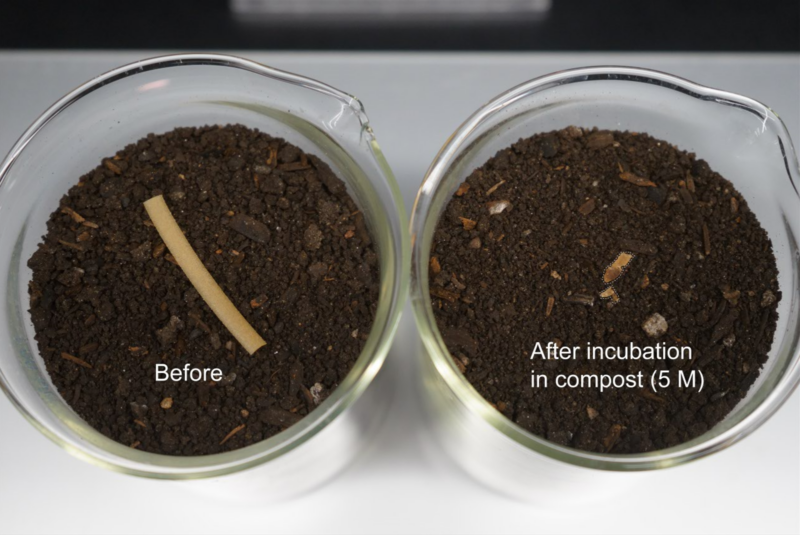
Han Sol Kim
One reason plastic waste persists in the environment is because there’s not much that can eat it. The chemical structure of most polymers is stable and different enough from existing food sources that bacteria didn’t have enzymes that could digest them. Evolution has started to change that situation, though, and a number of strains have been identified that can digest some common plastics.
An international team of researchers has decided to take advantage of those strains and bundle plastic-eating bacteria into the plastic. To keep them from eating it while it’s in use, the bacteria is mixed in as inactive spores that should (mostly—more on this below) only start digesting the plastic once it’s released into the environment. To get this to work, the researchers had to evolve a bacterial strain that could tolerate the manufacturing process. It turns out that the evolved bacteria made the plastic even stronger.
Bacteria meet plastics
Plastics are formed of polymers, long chains of identical molecules linked together by chemical bonds. While they can be broken down chemically, the process is often energy-intensive and doesn’t leave useful chemicals behind. One alternative is to get bacteria to do it for us. If they’ve got an enzyme that breaks the chemical bonds of a polymer, they can often use the resulting small molecules as an energy source.
The problem has been that the chemical linkages in the polymers are often distinct from the chemicals that living things have come across in the past, so enzymes that break down polymers have been rare. But, with dozens of years of exposure to plastics, that’s starting to change, and a number of plastic-eating bacterial strains have been discovered recently.
This breakdown process still requires that the bacteria and plastics find each other in the environment, though. So a team of researchers decided to put the bacteria in the plastic itself.
The plastic they worked with is called thermoplastic polyurethane (TPU), something you can find everywhere from bicycle inner tubes to the coating on your ethernet cables. Conveniently, there are already bacteria that have been identified that can break down TPU, including a species called Bacillus subtilis, a harmless soil bacterium that has also colonized our digestive tracts. B. subtilis also has a feature that makes it very useful for this work: It forms spores.
This feature handles one of the biggest problems with incorporating bacteria into materials: The materials often don’t provide an environment where living things can thrive. Spores, on the other hand, are used by bacteria to wait out otherwise intolerable conditions, and then return to normal growth when things improve. The idea behind the new work is that B. subtilis spores remain in suspended animation while the TPU is in use and then re-activate and digest it once it’s disposed of.
In practical terms, this works because spores only reactivate once nutritional conditions are sufficiently promising. An Ethernet cable or the inside of a bike tire is unlikely to see conditions that will wake the bacteria. But if that same TPU ends up in a landfill or even the side of the road, nutrients in the soil could trigger the spores to get to work digesting it.
The researchers’ initial problem was that the manufacturing of TPU products usually involves extruding the plastic at high temperatures, which are normally used to kill bacteria. In this case, they found that a typical manufacturing temperature (130° C) killed over 90 percent of the B. subtilis spores in just one minute.
So, they started out by exposing B. subtilis spores to lower temperatures and short periods of heat that were enough to kill most of the bacteria. The survivors were grown up, made to sporulate, and then exposed to a slightly longer period of heat or even higher temperatures. Over time, B. subtilis evolved the ability to tolerate a half hour of temperatures that would kill most of the original strain. The resulting strain was then incorporated into TPU, which was then formed into plastics through a normal extrusion process.
You might expect that putting a bunch of biological material into a plastic would weaken it. But the opposite turned out to be true, as various measures of its tensile strength showed that the spore-containing plastic was stronger than pure plastic. It turns out that the spores have a water-repelling surface that interacts strongly with the polymer strands in the plastic. The heat-resistant strain of bacteria repelled water even more strongly, and plastics made with these spores was tougher still.
To simulate landfilling or litter with the plastic, the researchers placed them in compost. Even without any bacteria, there were organisms present that could degrade it; by five months in the compost, plain TPU lost nearly half its mass. But with B. subtilis spores incorporated, the plastic lost 93 percent of its mass over the same time period.
This doesn’t mean our plastics problem is solved. Obviously, TPU breaks down relatively easily. There are lots of plastics that don’t break down significantly, and may not be compatible with incorporating bacterial spores. In addition, it’s possible that some TPU uses would expose the plastic to environments that would activate the spores—something like food handling or buried cabling. Still, it’s possible this new breakdown process can provide a solution in some cases, making it worth exploring further.
Nature Communications, 2024. DOI: 10.1038/s41467-024-47132-8 (About DOIs).
Listing image by Han Sol Kim
